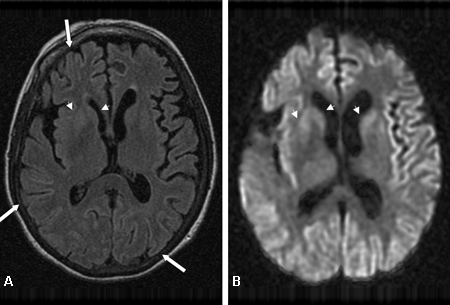Resumo
Definição
História e exame físico
Principais fatores diagnósticos
- cognitive impairment
- limb and/or gait ataxia
- myoclonus
- parkinsonism
- psychiatric symptoms
- visual changes
- age late 20s or mid-to-late 60s
- insomnia, dysautonomia
- positive family history
- nonspecific or constitutional symptoms
Outros fatores diagnósticos
- painful sensory symptoms
- movement disorder
Fatores de risco
- genetic predisposition
- prion-contaminated surgical instruments
- transfusion of blood or blood products (variant Creutzfeldt-Jakob disease)
- consumption of UK beef from 1980 to 1996
- consumption of US beef
- deer, elk, moose hunting in endemic regions of US and Canada
- use of human growth hormone
Investigações diagnósticas
Primeiras investigações a serem solicitadas
- brain MRI
- EEG
Investigações a serem consideradas
- quaking-induced conversion (QuIC)
- CSF biomarkers
- prion protein gene genetic testing
- biopsy (brain, tonsil)
Algoritmo de tratamento
all patients
Colaboradores
Autores
Valerie Sim, MD, FRCPC
Associate Professor
Department of Medicine
Division of Neurology
Centre for Prions and Protein Folding Diseases
University of Alberta
Edmonton
Alberta
Canada
Declarações
VS is principal and co-investigator on several research grants through the University of Alberta, to study prion disease and related neurodegenerative diseases. VS has one patent approved for the development of IgE-based prion therapy. VS is currently a site lead for the Ionis PrProfile trial. VS has been invited to give an educational session on prion disease at the American Academy of Neurology meeting in 2024.
Agradecimentos
Dr Valerie Sim would like to gratefully acknowledge Dr Michael D. Geschwind, Dr Amy Kuo, and Dr R. Ronald Finley, the previous contributors to this topic. MDG participates in the speakers' bureau for Pfizer, Forest, and Novartis; is consultant for MedaCorp, Gerson-Lehman Group, and Clinical Advisors Incorporated; and is an author of a number of references cited in this topic. RRF participates in the speakers' bureau for Pfizer, Forest, and Novartis. AK declares that she has no competing interests.
Revisores
Ali Hassoun, MD, FACP, FIDSA, AAHIVS
Infectious Disease Specialist
Alabama Infectious Diseases Center
Huntsville
AL
Declarações
AH declares that he has no competing interests.
Robert A. Larsen, MD
Associate Professor of Medicine
University of Southern California
Keck School of Medicine
Los Angeles
CA
Declarações
RAL declares that he has no competing interests.
William A. Petri, Jr., MD, PhD, FACP
Chief and Professor of Medicine
Division of Infectious Diseases and International Health
University of Virginia Health System
Charlottesville
VA
Declarações
WAP declares that he has no competing interests.
Créditos aos pareceristas
Os tópicos do BMJ Best Practice são constantemente atualizados, seguindo os desenvolvimentos das evidências e das diretrizes. Os pareceristas aqui listados revisaram o conteúdo pelo menos uma vez durante a história do tópico.
Declarações
As afiliações e declarações dos pareceristas referem--se ao momento da revisão.
Referências
Principais artigos
Department of Health. Minimise transmission risk of CJD and vCJD in healthcare settings. Nov 2021 [internet publication].Texto completo
Centers for Disease Control and Prevention. BSE (Bovine spongiform encephalopathy, or mad cow disease). Sep 2021 [internet publication].Texto completo
American College of Radiology. ACR appropriateness criteria: movement disorders and neurodegenerative diseases. 2019 [internet publication].Texto completo
Artigos de referência
Uma lista completa das fontes referenciadas neste tópico está disponível para os usuários com acesso total ao BMJ Best Practice.

Diagnósticos diferenciais
- Alzheimer dementia (AD)
- Lewy body dementia
- Frontotemporal dementia
Mais Diagnósticos diferenciaisDiretrizes
- ACR appropriateness criteria: movement disorders and neurodegenerative diseases
- Evidence-based guideline: diagnostic accuracy of CSF 14-3-3 protein in sporadic Creutzfeldt-Jakob disease
Mais DiretrizesConectar-se ou assinar para acessar todo o BMJ Best Practice
O uso deste conteúdo está sujeito ao nosso aviso legal